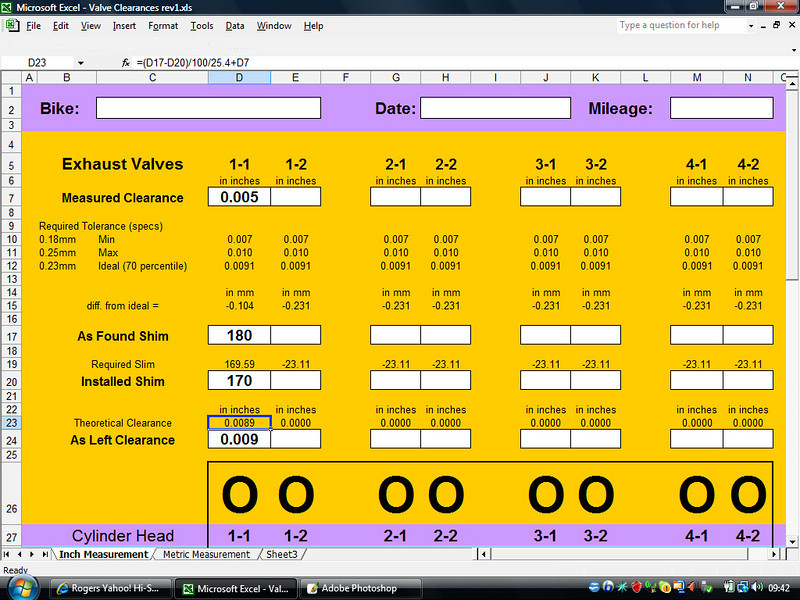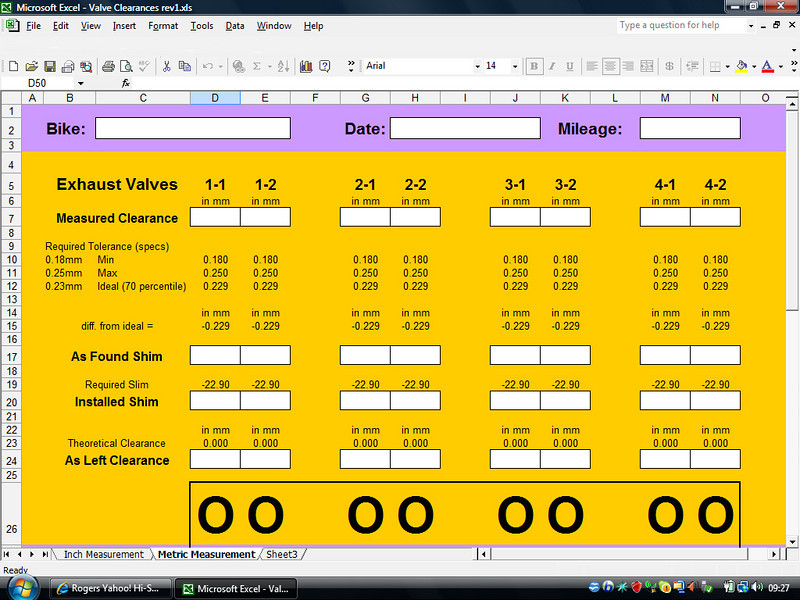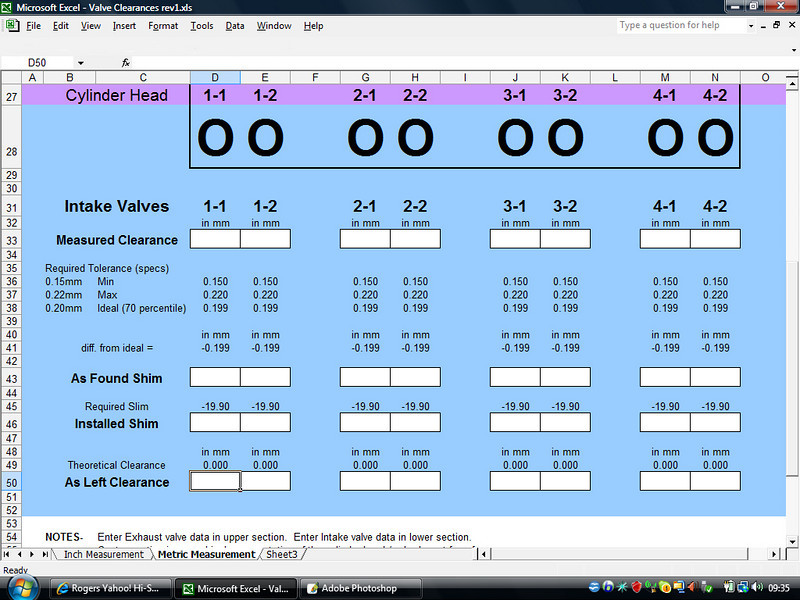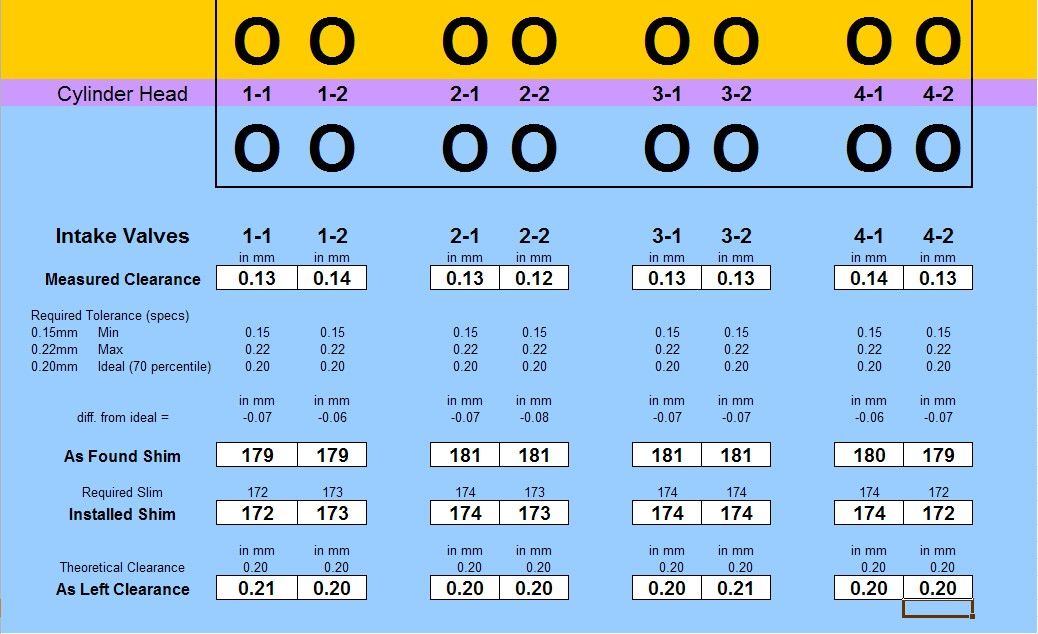yamafitter
Reigning NERDS Granite Lane Gold Medalist
In preparation of the recent Bustanut Tech Weekend in Owosso I put together a prototype Excel spreadsheet to help calculate the required shim and to act as a log for future reference.
I have shown this to RaYzerman19 and we used the prototype and found it useful.
When I got back I had posted about the spreadsheet and Fred W stepped up to the plate to massage it to make it more user friendly and griffisi also made some suggestions about a metric version.
Here are some screen shots of the final product...

And the metric version...


The top section is for the exhaust valves. I used the specifications for tolerance as per the Gen II manual for my '06 AE but all FJR's are the same.
If you are out of spec when you remove the shims you should measure them so that you have an accurate reading of the 'As Found' shim. With the 'As Found' Clearance input the spreadsheet calculates the difference from ideal in millimeters. The speadsheet then uses the 'difference' calculation and the 'as found' shim measurement to calculate the ideal shim thickness in millimeters.
Since the new shim will not likely be the exact thickness value when you input the actual thickness of the new shim (in millimeters) the spreadsheet will then calculate the 'expected' or theroetical clearance with the new shim installed. This acts as a check when you perform the final readings.
You can also use this part of the speadsheet to perform 'what if's' by plugging shim numbers in at the 'installed' row and see how much clearance that shim would produce.
The middle section is just a graphical representation of the valve layout and the bottom section is for the intake valves. The intake section is identical to the exhaust section except for the changes in specs.
As per Fred's & Ray's suggestion we used 70% of the maximum clearance to calculate the 'ideal' clearance to allow more tolerance for the valves to 'tighten up' between valve checks.
Fred has graciously offered to host the spreadsheet as part of the FJR NERDS file. Both Fred & I find this highly appropriate.
If you have a way of using an Excel file on your computer and think you would like this here's how to order...
Valve Clearance Spreadsheet
At the bottom of the spreadsheet you will see tabs labelled "Inch Measurement" & "Metric Measurement". Click on the tab for whichever type of feeler gauges you have. I'm old enough to use furlongs per fortnight myself.
Enjoy!
I have shown this to RaYzerman19 and we used the prototype and found it useful.
When I got back I had posted about the spreadsheet and Fred W stepped up to the plate to massage it to make it more user friendly and griffisi also made some suggestions about a metric version.
Here are some screen shots of the final product...

And the metric version...


The top section is for the exhaust valves. I used the specifications for tolerance as per the Gen II manual for my '06 AE but all FJR's are the same.
If you are out of spec when you remove the shims you should measure them so that you have an accurate reading of the 'As Found' shim. With the 'As Found' Clearance input the spreadsheet calculates the difference from ideal in millimeters. The speadsheet then uses the 'difference' calculation and the 'as found' shim measurement to calculate the ideal shim thickness in millimeters.
Since the new shim will not likely be the exact thickness value when you input the actual thickness of the new shim (in millimeters) the spreadsheet will then calculate the 'expected' or theroetical clearance with the new shim installed. This acts as a check when you perform the final readings.
You can also use this part of the speadsheet to perform 'what if's' by plugging shim numbers in at the 'installed' row and see how much clearance that shim would produce.
The middle section is just a graphical representation of the valve layout and the bottom section is for the intake valves. The intake section is identical to the exhaust section except for the changes in specs.
As per Fred's & Ray's suggestion we used 70% of the maximum clearance to calculate the 'ideal' clearance to allow more tolerance for the valves to 'tighten up' between valve checks.
Fred has graciously offered to host the spreadsheet as part of the FJR NERDS file. Both Fred & I find this highly appropriate.
If you have a way of using an Excel file on your computer and think you would like this here's how to order...
Valve Clearance Spreadsheet
At the bottom of the spreadsheet you will see tabs labelled "Inch Measurement" & "Metric Measurement". Click on the tab for whichever type of feeler gauges you have. I'm old enough to use furlongs per fortnight myself.
Enjoy!
Last edited by a moderator:




